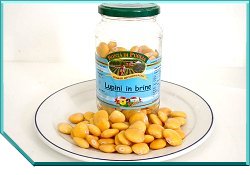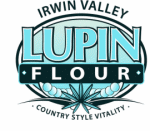PRODUCTS

    |

Consumer Goods & Health
Lupin foods are commercially manufactured in Europe, North America and Australia.
A small number of individuals suffer an allergic reaction to lupin which can result in anaphylaxis in some cases.
![]()
Traditional Mediterranean lupini bean
 Bitter large-seeded European white lupin (L. albus) is commonly eaten, after de-bittering, as a snack food preserved in brine (called 'lupini' or tremoços) in Portugal, Spain, France, Italy, Greece, Egypt and Algeria. Lupini beans are commonly sold in a salty solution in jars (like olives and pickles) and eaten by removing the skin and "popping" the seed directly into one´s mouth, but can also be eaten with the skin on. It is also popular in parts of Brazil, where it is often consumed as an accompaniment when drinking beer.
Bitter large-seeded European white lupin (L. albus) is commonly eaten, after de-bittering, as a snack food preserved in brine (called 'lupini' or tremoços) in Portugal, Spain, France, Italy, Greece, Egypt and Algeria. Lupini beans are commonly sold in a salty solution in jars (like olives and pickles) and eaten by removing the skin and "popping" the seed directly into one´s mouth, but can also be eaten with the skin on. It is also popular in parts of Brazil, where it is often consumed as an accompaniment when drinking beer.
Some product information:
www.alcofa.com/tremocos_small.jpg
www.homepage.oniduo.pt/nelsonsousa/imperial_e_tremocos.jpg
Fermented Soy Equivalents
Tempe is a traditional Indonesian food normally made by fermenting soybeans with the fungus Rhizopus oligosporus. Trial productions of lupin tempe have been conducted in Indonesia by Curtin University, Perth, Western Australia. Acceptable products have been produced.
Miso is a fermented paste popular in Japan made from soybeans and rice with an Aspergillus fungus. A sensory comparison of lupin and soybean miso, by 12 trained evaluators at the Shinshu Research Institute in Japan, found a substantial preference for the lupin product in terms of colour, taste and aroma.
The lupin product was also superior because it was less affected by discolouration due to oxidation.
Reference:
Coffey, R. (1989) “Lupins as an Energy-Rich Protein Source for Feed and Food” In: Vegetable Protein Utilisation in Human Foods and Animal Feedstuffs. Ed: T.H. Applewhite, pp. 410-414. American Oil Chemists Society, Champaign, Illinois
Lupin Kernel Flour Based Products
In Australia lupin kernel flour is milled by a number of companies including:
Irwin Valley Pty Ltd
 Irwin Valley shareholders are among the most innovative and progressive farmers in Western Australia and are all based in the Mid West region which, based on production figures and history, is arguably the foundation of Australia’s lupin industry. In addition to this, the association, with more than 100 grain producers, and the proximity to market, it is obvious to see why there is so much potential for projects such as Irwin Valley Lupin Flour.
Irwin Valley shareholders are among the most innovative and progressive farmers in Western Australia and are all based in the Mid West region which, based on production figures and history, is arguably the foundation of Australia’s lupin industry. In addition to this, the association, with more than 100 grain producers, and the proximity to market, it is obvious to see why there is so much potential for projects such as Irwin Valley Lupin Flour.
Irwin Valley Pty Ltd farms are quality assured with the majority also being compliant with Environmental Management Systems. These systems allow Irwin Valley Lupin Flour complete traceability and accountability from the shelf back to the individual grower and paddock.
Irwin Valley Lupin Flour
 It is our guarantee that all Irwin Valley Lupin Flour is produced with the highest regard to both food safety and the environment possible.
It is our guarantee that all Irwin Valley Lupin Flour is produced with the highest regard to both food safety and the environment possible.
Produced entirely in Western Australia, Irwin Valley Lupin Flour is completely quality assured and offers the consumer traceability for each individual bag of flour right back to the paddock in which it was grown.
Irwin Valley Lupin Flour meets HACCP regulations and is produced and processed in accordance with Environmental Management Systems (EMS) guidelines.
Corrow Seeds
 Coorow Seeds are suppliers of lupin flour, meal, dehulled lupin splits and whole lupins for stockfeed, aquaculture and human consumption.
Coorow Seeds are suppliers of lupin flour, meal, dehulled lupin splits and whole lupins for stockfeed, aquaculture and human consumption.
Mirfak, Victoria
www.mirfak.com.au
Retail outlets for lupin kernel flour include:
All About Bread Perth Western Australia.
www.allaboutbread.com.au
Both L. albus or L. angustifolius kernel flour has been included at 10-15% inclusion rate with durum wheat to make a lupin enriched pasta in Australia, Europe and the USA. The product has an improved balance of amino acids compared to the full wheat product.
In Australia some bakers manufacture a range of health breads containing lupin kernel flour. As lupins are gluten-free, breads can be made which are potentially suitable for people suffering coeliac disease.
Bodhis Bakehouse
References:
Lucisano, M. & Pompei, C. (1981) Baking properties of lupin flour. Food Science 14: 323-326.
Lupin Hull fibre
Avelup in Chile make a dietary fibre product from the hulls of L. albus.
In Australia, lupin hulls of L. angustifolius have been included in bread for many years by several bakers including:
Bakers Delight – Tiger Loaf: www.bakersdelight.com.au
European companies making lupin products
Soja Austria, Austria
L.I. Frank, The Netherlands
Lup’ingredients, France
Lupina GmbH, Visbek, Germany
Bioland Handelsgesellschaft Baden, Nurtingen Germany
CFM Multikost Lebensmittel GmbH, Germany
Firma Schnitzer GmbH & Co KG, Offenburg, Germany
Lupidor®- Hochdorf Nutrifood Ltd, Switzerland
NaPro Food- GmbH & Co KG, Germany
Recipes
Lupins can be used in a variety of healthy dishes as well as biscuits and cakes. Recipes can be found in the Passion for Pulses Cookbook. Details can be found at:
Internet Resources
Australian sweet lupin - is it the next human health food?
Presented at the 2003 DAFWA crop Updates this report into the use of lupin fibre in bread makes for interesting reading.
Lupin kernel fibre (LKFibre) is a novel food ingredient manufactured from Australian sweet lupin kernels.
Human dietary studies at Deakin University, in collaboration with Agriculture WA, University of Tasmania and industry partners have determined that LKFibre has potential in the manufacture of high-fibre and fat reduced food products that are acceptable to consumers and that have potential health benefits. This knowledge should catalyse the use of lupin by the food industry and assist in the expansion of the high value human food market for this important crop.
Lupins for human foods – Stuart Johnson Deakin University
http://www.research.deakin.edu.au/research_stories/research_story.php?s=33
An interesting webpage from Deakin University about the prospects for lupins in human foods
The name Lupin derives from the Latin for “wolf”, but there is no longer anything feral about the sweet lupin - decades of careful breeding have tamed it and made it an indispensable crop in Western Australia's sandplain wheat belt.
Now, food scientists want to complete the metamorphosis of the sweet lupin, Lupinus angustifolius, by making it a healthy, nutritious part of the Australian diet - a sort of home-grown equivalent of the soybean.
Australians can already buy a few boutique products made from lupin flour, like breads, biscuits and pasta, but Deakin University food scientist Dr Stuart Johnson believes the time has come for the sweet lupin to make its presence more strongly felt on supermarket shelves.
Recipes for using lupins and pulses in food
This book written by Nancy Longnecker from CLIMA (Centre for Legumes in Mediterranean Agriculture) provides recipes for all legumes, including lupins.
Bean and Cabbage Soup recipe which includes lupins
Grains Research & Development Corporation consumer guide to grains- Go Grains
Go Grains is a nutrition communication initiative established for the Australian grains industry, to provide quality information about the nutrition and health benefits of grains and pulses.
The above link will lead to the Go Grains home page which contains the following sub sections
Go Grains E-News
The Go Grains E-News Service is recommended for anyone with an interest in nutrition and health including dieticians, healthcare professionals, teachers, the media and food industry. This free, monthly email news update will provide you with brief highlights on the latest scientific research and health news compiled by Go Grains.
Grains Nutrition - information resource
Contains information on a wide range of topics related to grains, pulses and nutrition including production, processing, manufacture, nutrition, health benefits and marketing. There are sections on specific areas of interest such as functional foods and food legislation.
Grains Nutrition - food product development learning activity (CD Rom)
A self paced learning activity to assist students in developing their skills and knowledge in the areas of food product development and nutrition with a focus on grains. Includes extensive links to Internet based resources.
![]()
Low GI
The lupin grain is high in protein (30-40%) like soybean but is significantly higher in dietary fibre (30%) and lower in oil (6%) and contains minimal starch. It therefore has a very low Glycemic Index (GI), which has significant implications for western societies with an increasing incidence of obesity and associated risk of diabetes and cardiovascular disease.
Lupin has the lowest GI of any commonly consumed grain.
For more information on Glycemic index visit the website
There is considerable research currently aimed at determining the health benefits of lupins by dieticians and medical scientists in Europe and Australia. Much of the impetus for this has come from observing the increasing understanding of the health benefits of the soybean including the expanding interest in isoflavones and other nutraceuticals.
There is supportive scientific evidence that consuming lupin enriched foods may:
- Beneficially influence satiety (appetite suppression) and energy balance
A study achieved a 37 per cent reduction in the fat content of sausage patties by replacing meat fat with lupin fibre. The subjects ate fewer kilojoules at the test breakfast but maintained that lowered kilojoule intake for the remainder of the day.
Ref: Archer, BJ et al. (2004) Effect of fat replacement by inulin or lupin-kernel fibre on sausage patty acceptability, post-meal perceptions of satiety and food intake in men. British Journal Nutrition 91: 591-599.
- Beneficially influence glycemic control
Lupin flour inclusion into white bread significantly reduced the blood glucose response and the insulin response 11 men.
Ref: Hall, R. S., et al. (2005) Australian sweet lupin flour addition reduced the glycaemic index of a white bread breakfast without affecting palatability in healthy human volunteers. Asia Pacific J. Clinical Nutrition 14: 91-97.
- Improve blood lipids
Lupin fibre acts as a soluble fibre and drops the total cholesterol without affecting the HDL cholesterol. 38 men ate a control diet and a diet of food products enriched with Australian sweet lupin fibre for a month each. The study found that the lupin-enriched diet lowered total blood cholesterol by 4.5 per cent and the nasty LDL cholesterol by 5.4 per cent
Ref: Hall, R. S., Johnson, S. K., Baxter, A. L. and Ball, M. J. (2005) Lupin kernel fibre-enriched foods beneficially modify serum lipids in men. European Journal of Clinical Nutrition 59: 325-33.
- Lower hypertension
Lupins are the largest natural source of the amino acid arginine which has been implicated in having beneficial effects on endothelial function (improved blood vessel performance)
- Improve bowel health
Lupin foods reduce transit time, lower the colon pH (anti cancer) and act as a 'pre-biotic'.
Ref: Johnson SK, Chua V, Hall RS, Baxter AL. (2006) Lupin kernel fibre foods improve bowel function and beneficially modify some putative faecal risk factors for colon cancer in men. British Journal of Nutrition 95(2): 372-8.
Other References
Uauy, R., Gattas, V & Yanez, E. (1995) “Sweet lupins in human nutrition” In: World Review of Nutrition and Dietetics 77: 75-88 Ed. A.M. Simopoulos.
Sirtori, C.R. et al. (2004) Proteins of white lupin seed, a naturally isoflavone-poor legume, reduce cholesterolemia in rats and increase LDL receptor activity in HepG2 cells. Journal American Society of Nutritional Sciences 134: 18-23.
Australian research
European Union Healthy-Profood Project
Gluten free
Lupins are gluten free and are therefore potentially suitable for people with coeliac disease.
www.coeliac.org.au
www.gastro.net.au/diets/glutenfree.html
![]()
 Lupins have long been eaten by the Andean people of South America and by the peoples of the Mediterranean for thousands of years. Over the past 20 years an increasing number of Australian and Western Europeans have been exposed to a wider range of processed food products containing lupin based ingredients.
Lupins have long been eaten by the Andean people of South America and by the peoples of the Mediterranean for thousands of years. Over the past 20 years an increasing number of Australian and Western Europeans have been exposed to a wider range of processed food products containing lupin based ingredients.
The evidence points towards a relative low incidence of allergic reactions however the severity of the reaction of allergic individuals can be extreme. There are several well documented cases of anaphylactic shock linked to lupin consumption, although no fatalities have been recorded to date. It has also been demonstrated that it is possible for workers handling lupin flour to become sensitised to lupin via the respiratory system, which may subsequently lead to occupational asthma.
One case involved an adverse skin reaction of a 5-year old peanut-sensitive girl to a pasta product that had been fortified with lupin flour. The investigators then sampled seven peanut-sensitive adults and found that five also had positive skin prick tests to lupin-fortified pasta.
There are conflicting reports, but more recent studies indicate that the incidence of individuals with cross-reactivity to both lupin and peanut is probably lower than first thought.
The most significant cause of uncontrolled exposure to food allergens is incorrect labelling of a product that the consumer has considered safe. It is likely that labelling products containing lupins will become mandatory and that this will avoid problems associated with lupin becoming a 'hidden' or 'masked' allergen.
Some allergy clinics in Australia and Europe can skin-prick test to help identify individuals at risk of allergic reaction to lupins.
Research is continuing in Australia and Europe to better understand the causes and risks of lupin allergy.
Internet Resources
news.bbc.co.uk/1/hi/health/4419709.stm
Lupin Allergy- a UK perspective
This webpage from the Food Standards Agency-UK discusses the general issue of potential allergic effects from Lupins- and many other grains as well.
Allergy to lupin has been recognised for some time in mainland Europe, where lupin flour is used widely in food products. This type of allergy only seems to have started emerging in the UK quite recently, since lupin hasn’t been used much in food products here. Lupin allergy can cause severe reactions, including anaphylaxis, but there have been very few confirmed reports of lupin allergy in the UK so far.
The major allergens in lupin are also found in peanuts, so people who are allergic to peanuts could react to lupin. Lupin is mainly used in flour-based products such as pastry and pasta. People with peanut allergy should avoid foods containing lupin.
Because lupin flour is used more widely in mainland Europe, people who are allergic to peanuts or lupin should be especially careful when staying in other European countries or eating pastries etc. brought back from there.
Lupin Allergy- a Australian perspective
This webpage is from Food Standards Australia New Zealand.
A recent study in the Medical Journal of Australia (Vol 181:4, 16 August 2023) reports three cases of people with allergic reactions after eating products containing lupin.
Lupin is related to other legumes, including peanuts and soy. Lupin has been a food ingredient in Europe for many years where it has been used to replace cereal grains in food products such as flour or pasta. However, it is not a common food ingredient in Australia. Lupin is grown in Western Australia, mainly for use in stock feed.
Food Safety First Before Developing New Dishes – GrainFoods CRC
www.grainfoodscrc.com.au/documents/Press%20Release%20-%20Lupin%20Paper%20-%20Final.doc
The Grain food CRC is investigating potential applications of lupins as food products utilising a systematic research approach. In response to concerns regarding lupin toxicity the GFCRC conducted a review of the current literature.
“Review of the food safety issues relating to the human consumption of lupins” prepared by Joanne Bradbury, Stephen Myers and Ken Quail for the Grain Foods CRC takes a look at possible allergens in lupin flour. Spokesperson, Ken Quail said “We wanted to understand any potential problems and head them off at the pass so to speak”.
![]()
In ancient times lupin flour was used as a treatment for tired skin. Lupin oil contains a range of antioxidants from the carotenoid and tocopherol group.
Some cosmetic companies use lupin ingredients in their skincare products.